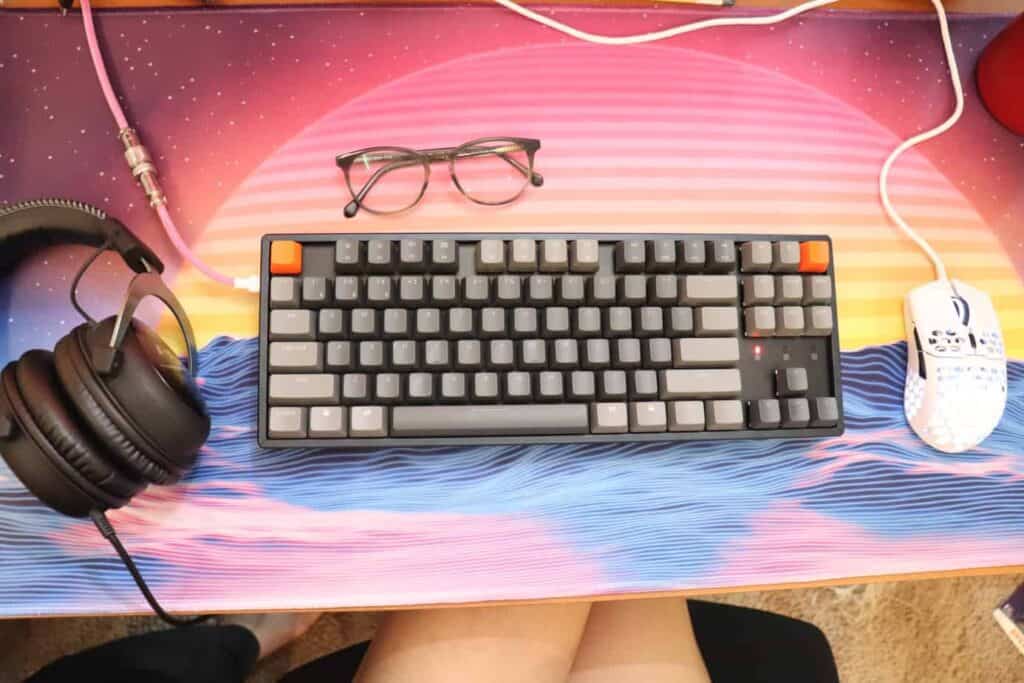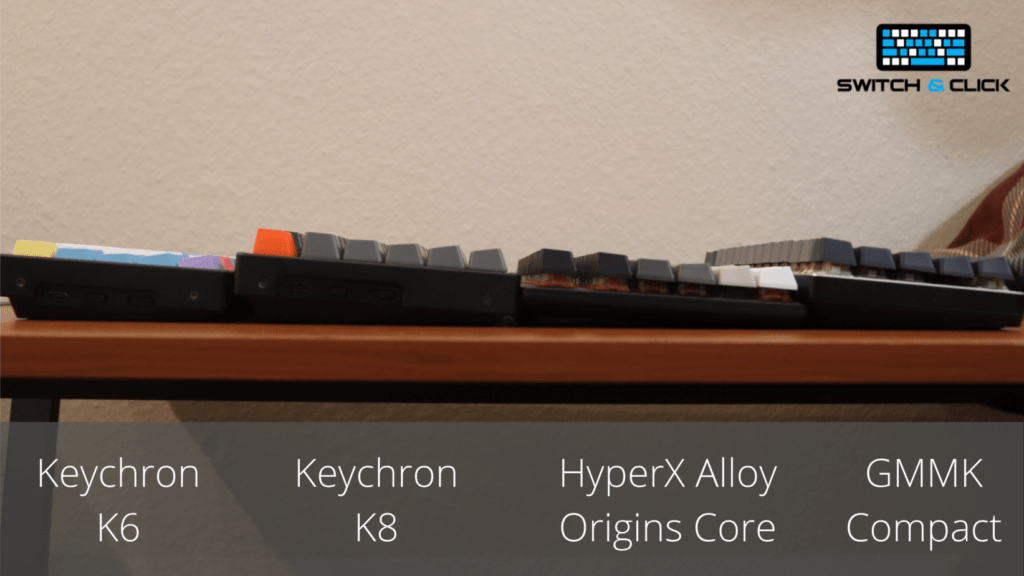Keychron is a company that builds keyboards with unique layouts that are hard to find elsewhere. They are most known for the K1, K2, K4, K6, K8, but what are the differences between these models?
The Keychron K1 is a tenkeyless or full-sized low-profile keyboard. The K2 is 75% layout with a function row. The K4 is an 1800 compact (96% layout) that is slightly smaller than full-size. The Keychron K6 is a 65% layout with hot-swap sockets and is slightly more slim than the K2 and K4. The K8 is tenkeyless.
All Keychron keyboards have similar features such as wireless and Mac compatibility.
We’ll go more into detail about the differences and talk about the layouts and features associated with each Keychron keyboard model to help you figure out which one may be the right keyboard for you.
What are the Different Keychron Models?

| Keychron Model | Keyboard Size |
| Keychron K1 | Full-sized/Tenkeyless Low Profile |
| Keychron K2 | 75% Layout |
| Keychron K4 | 1800 Compact |
| Keychron K6 | 65% Layout |
| Keychron K8 | Tenkeyless |
Keychron is a company based out of the UK and is focused on make unique and minimalistic keyboards. Keychron has four different keyboards in its lineup including the K1, K2, K4, K6, and K8.
It can be confusing to keep track of all the differences, so we’ll go over exactly what makes them unique.
They each feature unique layouts including 96%, 75%, 65%, and tenkeyless.
Keychron K1

The K1 is a low-profile mechanical keyboard. The K1 is has wireless & wired capabilities and is easy to use to both Mac and Windows computers.
The K1 comes in either tenkeyless or full-sized layout, with the full-sized layout costing an additional $20. We went for the full-sized layout for the purpose of our review.
You also get to pick between Gateron Low Profile Red/Blue switches, depending on if you want clicky feedback or a linear switch.
In addition, you can also pick between white back lighting or full RGB lighting. The RGB lighting comes with 18 different settings, so there are a lot of options to get the perfect light set-up for you.
The price comes out between $74 – $94, depending on if you want TKL or full-sized, and if you want RGB or white backlighting.
Overall, the keyboard has a nice aesthetic, but the low profile switches may be difficult to type on. When we tested the keyboard out, we found it difficult to get used to typing on, and had to slow our typing speed to avoid finger pain from impact during keystrokes. We have a more in-depth full review of the K1 here.
If you’re interested in trying out the keyboard for yourself, you can find the K1 through this link listed on Amazon for a competitive price.
Keychron K2

The K2 is a 75% keyboard layout, this means that the keyboard does not have a numberpad and only part of the home cluster.
You can see our favorite 75% keyboard picks here.
The K2 is a mechanical keyboard with wireless functionality, which can connect to 3 devices at once making it quite easy to toggle between devices.
The keyboard also has an impressive battery that can last up to two weeks. The keyboard is also functional with Windows and Apple operating systems as well. Located on the side of the keyboard is a sliding switch that makes it easy to toggle between the different operating systems.
Out of the K2, K4, and K6, the K2 had the best keycaps, they are high contrast which makes them much easier to see and use.
We also found the 75% layout to be the most efficient as well. The K6 had the same overall width, but had less total keys, so you don’t save much space at all.
The only things we didn’t like about the K2 was how thick the keyboard is. It makes it very difficult to type on without a wrist rest and can cause some wrist pain.
On top of that, the USB-C power cable connection was on the left side of the keyboard which is a little awkward to plug in. Usually the port is located on the backside of the keyboard.
Keychron K4

The Keychron K4 is a widely available 1800 compact mechanical keyboard prebuilt.
This keyboard is the only one on the list that is wireless and features Windows/Apple compatibility. The keyboard comes in a light grey/brown aesthetic, with a boxy rectangular look to it.
You have your choice between Gateron Red, Blue, Yellow, and Brown switches, so you can really customize how the keyboard feels. This keyboard also has RGB LED lighting so you can type easily in the dark.
The layout places the home cluster laid out horizontally instead of the usual 3×3 grid layout. This conserves space and makes the keyboard even more narrow. In addition, there are also some addition keys to control the RGB backlighting of the keyboard. It may take a little while to get used to this layout, but the keys aren’t used too often anyways so it shouldn’t impact the typing experience too much.
Some of my main criticisms of this keyboard, and Keychron keyboards in general, is how high the front of the keyboard is.
This can be uncomfortable or even painful on the wrists and is difficult to use without a wrist rest. With a wrist rest it’s slightly better, just be ready for the keyboard to be a little bit higher in the front than usual.
Overall, it’s a great keyboard that’s absolutely packed with features. If this sounds interesting to you, you can check it out on Amazon for a relatively cheap price.
Keychron K6

The Keychron K6 is a 65% sized keyboard (Amazon), which means it does not come with a numberpad or the very top row that comes on standard keyboards.
The overall design is very similar to the Keychron K2, but instead of being a 75% layout (meaning no number pad), the K6 it is scaled down to smaller, more bite-sized 65% layout.
Loaded with features, the K6 and allows you to customize whether you want a lighter, cheaper plastic base or a more sturdy, pricey aluminum base.
The aluminum base will give the keyboard a more solid feel and may be better if you plan on primary keeping the keyboard in one place.
The plastic base is a few ounces lighter and is better if you plan on using the wireless capability more or want to take it on the go.
The lighter weight makes the keyboard easier to carry and more portable. Overall, the aluminum base will cost about $10 more.
My favorite feature of the K6 is the choice of getting hotswappable switches. It’s easier than ever to swap out keyboard switches. Without having to solder a single switch, all you need to do is pull out the old switches with a switch puller and press the new ones into the PCB.
This keyboard was recently released through a Kickstarter and started to ship in March/April of 2020.
You can find the K6 on Amazon through this link for a good price.
Keychron K2 vs K6
The Keychron K2 and the Keychron K6 are very similar, with the K2 being a slightly larger (75%) size than the K6 (65%). The K6 is smaller than the K2 because it does not have the function row. The Keychron K6 is also hot-swappable, while the Keychron K2 is not. The K6 is also about 1mm less thick than the K4 making it easier on the wrists.
Keychron K8

The Keychron K8 is the newest keyboard from Keychron, we have a full review here.
The keyboard is similar to the other models except it is tenkeyless, wired/wireless, and hot-swappable. With similar features to the K6, the K8 is absolutely loaded with amazing features.
We were quite impressed with the keyboard once we got our hands on it. It was excited to see another keyboard from Keychron have hot-swappable sockets. Keychron does plan on going back and updating all of the old models eventually, so it should be cool to try each updated model in the future.
The case design is floating keycap with an aluminum bezel containing the keys. The bezel helps from the keyboard producing too much noise as it insulates the keyboard nicely.
We found that going through and lubing the switches, modding the stabilizers, and adding some foam really took this keyboard to the next level and made it super enjoyable. You can find the K8 on Amazon through this link.
The Height Difference Between The Different Keychron Models

| Keyboard Model | Front Keyboard Height | Back Keyboard Height |
| Keychron K8 | 3.2 cm | 3.9 cm |
| Keychron K6 | 2.8 cm | 3.4 cm |
| Keychron K2/K4 | 3.4 cm | 3.6 cm |
| GMMK Compact | 3.0 cm | 3.9 cm |
| HyperX Alloy Origins Core | 2.6 cm | 3.2 cm |
Keychron keyboards have notoriously been taller than other keyboards, so Keychron has received some negative feedback in the past in regard to that design choice. The question is, how do the heights of the various Keychron models compare with each other and other keyboards? We put together a table full of different keyboard heights so you can see for yourself how they compare.
As you can see, the Keychron K8 is slightly shorter in the front than the K2/K4, and is actually half a centimeter taller in the back. This can be attributed to a more angled keyboard, which I have found feels slightly better to type on.
The Keychron K6, however, has the shortest dimensions of all the keyboards from Keychron, so that may be a good choice for someone who’s not sure about the keyboard thickness. Personally, I don’t mind the thickness of the K8, but I could see how it might be a big sticking point for other people.
When compared to a normal tenkeyless layout, such as the HyperX Alloy Origins Core, the Keychron K8 is a little over half a centimeter taller. While it is noticeable, the extra thickness is not as bad as some make it out to be. The GMMK Compact, for example, is a 60% layout that is just as thick as the K8 and feels great to type on.
The Winner? The Keychron K2… for now

Between all of the different Keychron models, our favorite was the K2.
We found the 75% layout of the K2 to be the most efficient and fun to use, making it the best. The K2 also had the best keycaps in our opinion, which is a glaring weak point of the Keychron keyboards. We had a little fun and swapped out the keycaps on a few of the Keychrons and found they drastically improved the typing experience. We recommend getting a cheap set of PBT keycaps and swap out the thin, dull ABS keycaps that come standard on the Keychron boards.
If you really want to try out some different switches, it may be worth getting the K6 instead since that keyboard has hot-swap sockets and you can change out the switches without needing to solder/de-solder. Other than that, we’ll go with the K2 any day of the week.
Conclusion
As you can see Keychron’s keyboard lineup is quite unique and loaded with different layout options. Each keyboard has wireless & wired functionality and Mac/Windows compatibility. They would make a great keyboard for working in an office due to their professional and minimalist look. In addition, they are affordable and competitive with other keyboards on the market.
